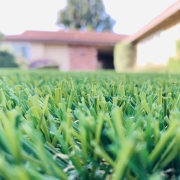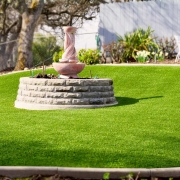What Type of Synthetic Turf Infill is Right for Me?
“Infill” refers to the products that are placed between the blades of an artificial turf lawn, filling in the otherwise empty spaces. This infill aids synthetic grass in a number of different ways; it helps the turf blades maintain their upright position and shields the turf’s backing from the sun’s UV rays. It also helps give artificial grass the feeling of natural sod grass, with infill mimicking the way soil absorbs impacts. Lastly, infill weighs the turf down to prevent it from developing wrinkles, buckles, or ripples. If you’re considering adding a synthetic turf installation to your Sacramento home or business, you should consider the different types of infill available to determine which one suits your needs best.
Silica Sand
One of the most common types of infill, silica sand is also one of the most inexpensive. Sand infill is created from quartz stones after they’ve been heavily eroded by wind and water into small granules. Silica sand not only helps keep turf standing upright, but it also improves the turf’s drainage and prevents puddles from forming on the surface of the lawn. Sand is best used in areas that receive light foot traffic, such as hills, balconies, commercial spaces, or open fields that aren’t used often.
Envirofill
Consisting of green silicone dioxide granules, Envirofill is designed to be a bacteria-free and non-toxic infill solution. Utilizing Microban antimicrobial technology, Envirofill provides a sterile environment for any bacteria that attempt to grow and reproduce in your turf. The end result is a turf solution that is inhospitable for microbes, but still clean and welcoming for pets and people. Envirofill is often used in areas where the transmission of bacteria is a common issue, such as children’s playgrounds and athletic fields.
Zeofill
Zeofill is a non-toxic and biodegradable infill solution made up of zeolite granules. Zeolites are a type of mineral frequently used in commercial applications as absorbents; this means that they excel at capturing and neutralizing chemicals that create unpleasant odors. Zeofill is most frequently seen in lawns that are used by animals as a bathroom, such as in dog kennels and the homes of pet owners. Zeofill can capture and neutralize the ammonia in pet urine, which is what creates foul smells. Zeofill does not require the usage of liquid turf deodorizer products, but it can work in tandem with them if the owner still wishes to use such products. Another advantage of Zeofill is that its granules do not compress easily, making it less likely that they will compact and negatively affect the lawn’s drainage.
No matter what type of synthetic grass infill you choose, Artificial Turf by Fenix can help you achieve the lawn of your dreams. Our team of synthetic turf experts can help you design and install the lawn you’ve always wanted for your Sacramento home or business, letting you enjoy a fresh green exterior all year long with minimal maintenance requirements. Give us a call today at (877) 673-8873, and we can provide you with a free estimate for your project.








